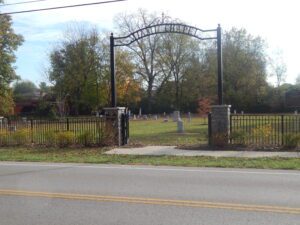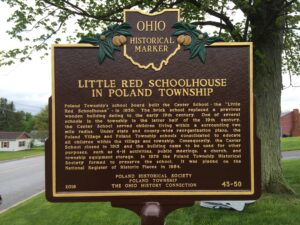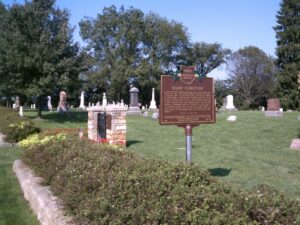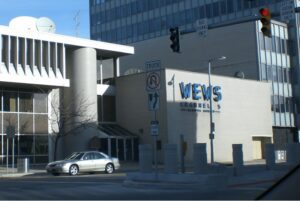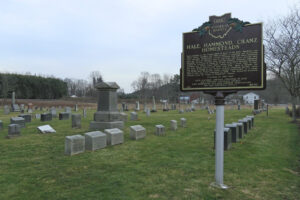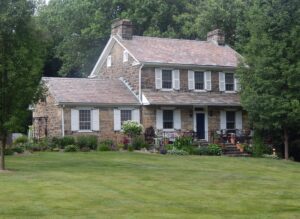, OH
Landscape architect Howard Daniels designed the original portion of Green Lawn Cemetery in 1848. Noted Columbus architect Frank Packard designed Green Lawn’s Chapel mausoleum, the Hayden family mausoleum, and the Packard mausoleum. Spanning over 360 acres, the cemetery’s wooded setting provides a habitat for a variety of birds and other wildlife. The Chapel contains stunning stained glass windows and mosaic artwork by Tiffany & Company of New York. The monuments, obelisks, and memorials throughout the cemetery represent a wealth of artwork and a history of Columbus. As one of the oldest and largest cemeteries in Ohio, Green Lawn is the resting-place of many noted individuals who have made significant contributions to Columbus, Franklin County and the nation.
, OH
Around 1843, local Methodists organized a new Methodist Episcopal church at Fair Play and later erected a brick chapel. The congregation was short-lived, however, and fell into decline after one of its leading members, Joseph Lashorn, moved to Hamilton. In 1876, Reverend F. G. Grigsby of the United Brethren church organized a congregation here, repairing and occupying the old Methodist chapel for the next several years. The cemetery is the burial place for veterans from the Revolutionary War, War of 1812, and Civil War; some of whom are interred in unmarked graves. The last known burial was Etta Thomas in 1941.
, OH
Poland Township’s school board built the Center School- the “Little Red Schoolhouse”- in 1858. The brick school replaced a previous wooden building dating to the early 19th century. One of several schools in the township in the latter half of the 19th century, the Center School served children living within a surrounding two mile radius. Under state and county-wide reorganization plans, the Poland Village and Poland Township schools consolidated to educate all children within the village and township. Consequently, the Center School closed in 1915 and the building came to be used for other purposes, such as 4-H activities, public meetings, a church, and township equipment storage. In 1979 the Poland Township Historical Society formed to preserve the school. It was placed on the National Register of Historic Places in 1984.
, OH
In 1829, Samuel and Charlotte Hale Shaw came to Bath Township from Bristol, New York. They purchased 145 acres of land where Samuel, a carpenter, built a two-story frame house. They had six children; two died in infancy. Their two year old daughter, Charlotte, was the first to be buried in Shaw Cemetery. They conveyed one half acre of land to the township for a “burying ground” in 1836. Samuel died in 1836; Charlotte then married Lyman Doolittle. They had five children; two daughters survived to adulthood. In 1892, Virgil E and Genevieve Doolittle Shaw sold one acre to Bath Township to expand Shaw Cemetery. Samuel’s parents, Constant and Mercy Pitts Shaw, migrated to Bath Township along with his brothers and their families.
, OH
One of America’s most admired women, pioneer television newscaster Dorothy Snell Fuldheim (1893-1989) began her career as a lecturer in the 1920s and entered broadcasting with a biographical series on WTAM radio in Cleveland. In 1947, Fuldheim joined Ohio’s first commercial television station, WEWS, becoming the first woman in the United States to anchor a news show. Her later work included the long-running “One O’clock Club” live interview show and regular news commentary. During her six-decade career in an often youth-dominated profession, Fuldheim conducted over 15,000 interviews-including Adolf Hitler, Benito Mussolini, the Duke of Windsor, Albert Einstein, and Helen Keller-in a unique and erudite style. She retired in 1984 at the age of 91.
, OH
Established as the Oxford Township Cemetery in 1880, this public graveyard replaced the original one at the corner of College Avenue and Spring Street. That earlier burial ground was abandoned when the railroad bisected it in the 1850s. New cemeteries were established including the privately incorporated Oxford Cemetery, the Catholic Mt. Olivet Cemetery, and this one, renamed Woodside Cemetery in 1931. Bodies transferred here from the original graveyard included those of early 19th-century settlers, who were reinterred in the “Pioneer Quad” at the south end. The cemetery includes veterans of the nation’s wars, including one from the 54th Massachusetts regiment of Civil War fame, and generations of African Americans, who comprised 20% of Oxford’s population in the late 19th century. Maintained by the township and then jointly by the township and city, Woodside became solely the city’s responsibility in 2002.
, OH
This cemetery is the resting place of many of the Hale, Hammond, and Cranz family members who were integral in founding and developing Bath Township. Connecticut natives Jonathan Hale and Jason Hammond were the first to purchase land in the area that would become Bath Township. In 1810, Jonathan Hale and his nephew, Theodore Hammond, arrived at Township 3, Range 12 of the Connecticut Western Reserve. Jonathan and Mercy Piper Hale’s family built a brick home in 1827. The Hale family lived in this home until 1956, when it became the Hale Farm & Village of the Western Reserve Historical Society. Jason and Rachel Hale Hammond’s family started construction on a frame home in 1818 that was completed in 1836. The Hammond property extended from the valley to Hammond’s Corners. (Continued on other side)
, OH
The Kyle-McCollum House, thought to be the oldest continuously inhabited residence still on its original site in Youngstown, was built by War of 1812 veteran Joshua Kyle (c. 1766-1842) and his wife Mary Stewart (c. 1774-1844). The Kyles moved from Westmoreland County, Pennsylvania, to the Mahoning Valley around 1800 and purchased about 1,300 acres of land on a hill above Mill Creek. Using stone quarried from the property, they built a house, completed in 1813. The Federal style of the house is typical of early 19th-century homes built in the Connecticut Western Reserve. The structure is two and a half stories with stone load-bearing walls that are two feet thick. Beside his farm, Kyle built a sawmill on Mill Creek near Slippery Rock, a site now under Lake Glacier. [Continued on other side]



